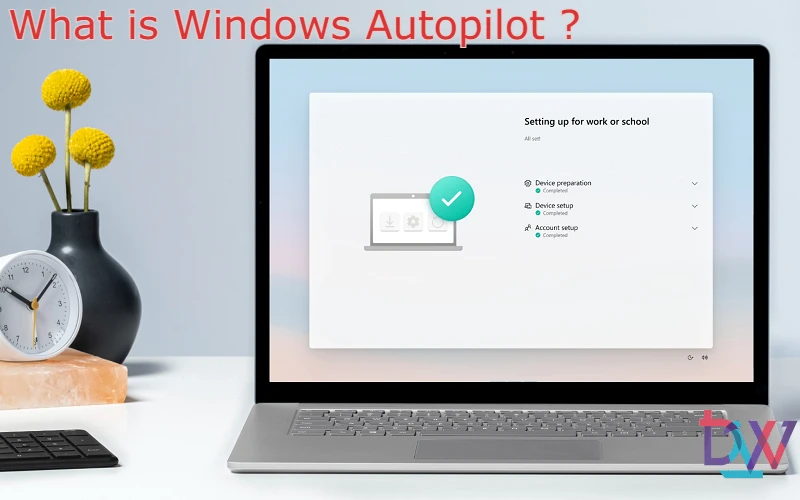Windows AutoPilot can help you deploy faster and save you a lot of time and money. Let’s take a look at how it works, how it integrates with Intune and Azure AD, and what a typical AutoPilot use case looks like.
What is Windows AutoPilot?
Windows AutoPilot is an end-to-end, virtually touchless Windows device management solution. Think for a moment about the typical machine lifecycle management process in your organisation. You probably manage WIM files for every device model and operating system version. And this custom image management process can be a huge time sink. First, you have to create each custom image, which requires upfront labour costs and resources. Then you have to establish the infrastructure to maintain those images. Finally, you must use these images appropriately and maintain them in a ready-to-use state for each new model introduced into your ecosystem. And let’s not forget that you’ll need to update these images with every Microsoft update.
Windows AutoPilot lets you say goodbye to those custom images, and hello to automated OS deployment. And you can :
- Automatically associate devices with Azure AD
- Automatically enroll devices in Intune
- And, best of all, the only interaction required during OS deployment is connecting to the network and entering credentials. Beyond that, everything is automated.
This means you no longer need to buy thousands of devices, send them to IT, delete them, download custom images, and then redeploy them to staff. In fact, the IT department doesn’t have to touch the device at all. Users simply connect to the Internet, log in and AutoPilot takes care of the rest.
But let’s not get carried away. To fully understand AutoPilot, you need to know about Intune and Azure AD.
What is Microsoft Intune?
AutoPilot is the lever that unlocks the automated deployment of Intune. So to understand AutoPilot, you need to understand Intune. The easiest way to describe Intune is to say it’s a cloud-based device manager. But it’s really a comprehensive enterprise mobility management solution, as it helps with compliance, mobile provisioning and security.
Intune registers devices in your IT ecosystem, configures them, creates reports and even helps remove corporate data from devices after they are used. Intune works with all Windows OS AND Mac OS devices. And you can take advantage of some handy third-party integrations to include Linux in that list. Intune is your primary device management tool, and it has far surpassed MECM (SCCM) for a large portion of the device management use cases.
What is Azure AD?
Azure AD is Microsoft’s identity management solution. Azure AD offers universal value in identity management and has quickly become a staple of Microsoft ecosystems. But it’s important to note that Azure AD can manage your entire technology ecosystem. And you can use Azure AD Connect to synchronise identity control across your technology stack. This makes Azure AD a centralised identity solution rather than a granular Microsoft-specific system.
Benefits of using Azure Autopilot
Windows Azure Autopilot or Microsoft Azure deployment offers organisations the following benefits:
- Assists in large-scale enterprise device deployment: With Azure Autopilot, organizations can deploy hundreds of devices with minimal administrator interaction, reducing the time spent configuring and provisioning devices.
- Automated user assignment: Employees can automatically register devices enrolled using Windows Autopilot with their respective Azure accounts. This significantly reduces the time spent distributing applications and content to devices.
- Eliminate the need for OS imaging and deployment: With Microsoft Autopilot, you can ensure that devices have the necessary applications, content, and configurations in place of the time-consuming OS imaging process.
- Customizable Branding: Companies can optionally rebrand the login screen with a company logo, banner and custom text while configuring Windows Autopilot, and provide the device user with a customized OOBE experience.
Understanding the relationship between Windows AutoPilot and Intune
The out-of-the-box promise of AutoPilot is linked to Intune, which acts as a driver for device installation and updating. Here’s how it works.
- IT sets up the AutoPilot workflows and registers the devices in Intune. During this step, IT will need to obtain the device ID from the hardware vendor.
- Your company purchases new devices.
- Users unpack the devices and log into their Microsoft account (with an active network connection).
- Intune synchronises AutoPilot and the devices and sends configurations and updates for the devices.
Some points to note
- AutoPilot works by attaching the device to Azure AD. So if you’re using a hybrid setup (not a full Microsoft ecosystem), you’ll probably use MCM and AD to help with device configuration workflows. But you can also manually provision existing devices in Azure AD. So AutoPilot is still useful for your existing assets as well as your new assets.
- AutoPilot requires one of the following licenses: Microsoft 365 Business, Microsoft 365 F1, Microsoft 365 E3 or E5, Enterprise Mobility & Security E3 or E5, or any other license that provides AAD/MDM services.
- Your provider must support AutoPilot. Almost all vendors that already support SCCM custom image creation have signed up for AutoPilot. But there are certainly use cases where vendor support is non-existent.
- You need Windows 10 version 1703 (or later)
While AutoPilot is intended for Windows 10 devices only, Intune can be used to provision all mobile devices in your business.
Windows Autopilot in detail
Again, this is an emerging technology, which is non-disruptive and doesn’t require a bunch of extra technology to use properly. In fact, AutoPilot achieves three main objectives.
- Save money and time by reducing the touch points of IT staff.
- Introduce ease of use into device configuration.
It is easier to think of AutoPilot as an evolution of device management. These three main drivers have many benefits.
No need to manage images and drivers
Custom images are really tedious. Not only are they time-consuming to create (and you have to update them every time you deploy), but they require you to literally delete every device. AutoPilot and Intune require absolutely no custom images, and you only need to contact the manufacturer to get the device ID during the Intune provisioning steps.
There is no need to manually configure devices (Near Zero Touch)
Remember that AutoPilot retrieves the provisional information from Intune, so IT does not have to touch the devices. It’s not that IT never has to touch the device (they may still have to set up admin rights), but they will have to deal with the devices much less often. Users provision their own devices via a connection. AutoPilot/Intune takes care of the rest.
A simple process for end users
Cloud automation on the user side is only valuable if it is simple. And AutoPilot is the definition of simple. Users will only have to perform two steps: connect to the network and log in. And that’s it!
Easily reset devices to a ready-to-use state
IT can quickly return devices to their previous state with AutoPilot/Intune integrations.
A typical Windows AutoPilot use case
Let’s look at how you can use AutoPilot for device management.
To get started, your organisation needs to sign up for AutoPilot. If you are just starting out, you will need to manually add any devices you already have in your ecosystem. Adding new devices will likely be done automatically, as most vendors have signed up for AutoPilot. So when you buy a new device, IT only needs the AutoPilot device ID from the vendor side.
Then IT will be responsible for configuring AutoPilot and defining profiles. IT can choose which profiles have administrative privileges and which do not during this phase (note: you can add privileges later as needed). This is pretty much the last step where IT needs to be involved. That’s right! No custom image files or manual deletion of devices. Instead, you ship the devices directly to the user, who provides their own self-service device.
Once the user has their device, they connect to the company network and log in. From there, AutoPilot will recognise the device and start to introduce configurations to it via the cloud. This means that the IT department does not have to spend valuable time injecting drivers and updating applications. Everything is automated.
Conclusion
Autopilot is an incredibly valuable tool for IT professionals and businesses who want to save time, money and frustration during the device provisioning process. In addition, AutoPilot joins a long list of Microsoft cloud solutions aimed at making life easier for business users.


